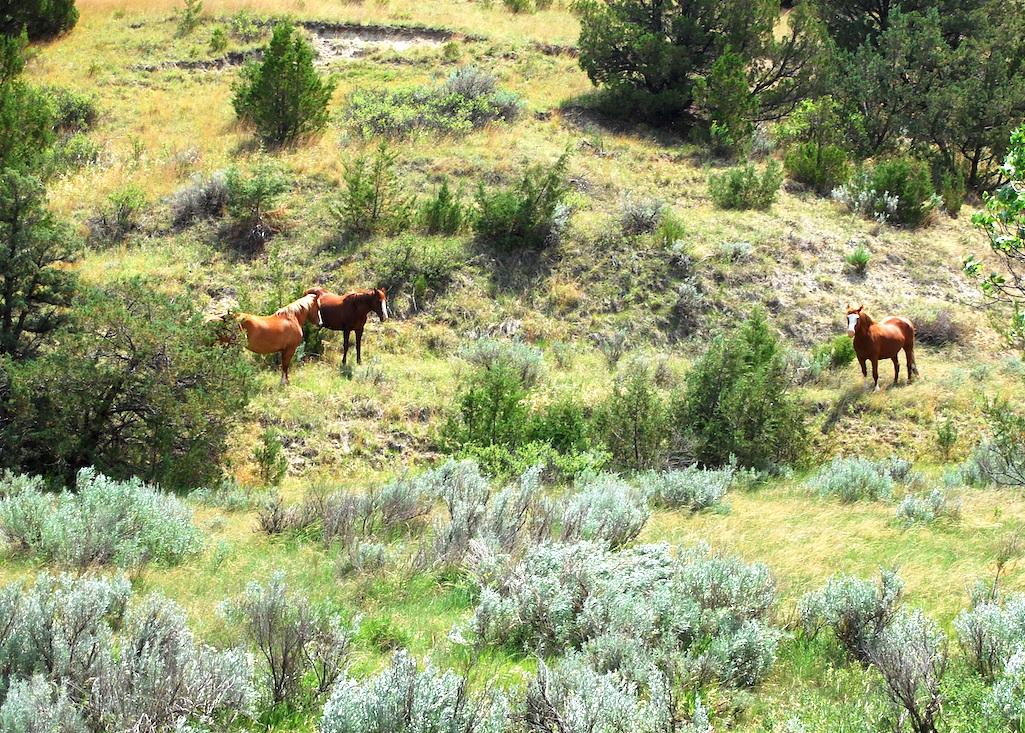
Should feral horses be removed from Theodore Roosevelt National Park?/Kurt Repanshek file
Op-Ed | Feral Horses Should Be Removed From Theodore Roosevelt National Park
By George Wuerthner
Theodore Roosevelt National Park has proposed eliminating feral horses and domestic livestock from the park. Unlike the fiasco at Point Reyes National Seashore, where the National Park Service appears to support maintaining domestic livestock within the park unit, the staff at Theodore Roosevelt recommends reducing the number of domestic animals to zero. Management of feral horses and domestic cattle across the West has been contentious for decades.
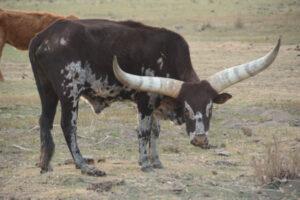
TRNP has a small herd of domestic cattle which it plans to eliminate/George Wuerthner
Opposition to the proposal comes from the Governor Burgum of North Dakota, the state Legislature, and the United Tribes of North Dakota. Burgum, speaking on behalf of the hospitality industry, suggests that horses and cattle are a draw for tourists and are part of the ranching “heritage” of the state.The state Legislature is also considering a resolution that would oppose the removal of livestock from the park. But, of course, this would only be advisory since federal authority trumps state laws.
The tribes, for their part, argue that horses are “sacred” and part of their cultural heritage.
Although the Park described the horses for decades as “wild horses” or “feral horses,” park officials recently classified them as livestock and maintain they have “no basis” to keep livestock in the park under laws and regulations.
Park officials, including Angie Richman, the park superintendent, have said the park’s enabling legislation and other federal laws don’t allow them to keep livestock in the park. The park’s mission, Richman has said, is to preserve native species and ecosystems.
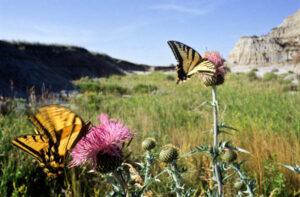
TRNP’s mission is to manage for prevation of natural values and biodivesity. Tiger swallowtail on thistle Theodore Roosevelt NP/George Wuerthner
The cattle management within the Park relies on a 1970s plan, while the feral horse plan was adopted in 1978. The 1978 plan called for 35-60 horses. Today there are more than 200, well above the original plan.
The Park has tried to limit the number of horses through periodic roundups and even birth control. But the horses, say the NPS, are “efficient breeders.”
The NPS says that based on new science, and ecological insights, the removal of horses and domestic cattle should be the priority of park management.
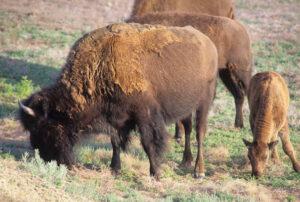
A new cattle borne disease poses a risk to the park bison herd/George Wuerthner
A further issue is that Theodore Roosevelt National Park is home to bison, and in 2022 a bacterial disease of cattle, Mycoplasma bovis, was discovered in the park. Mycoplasma bovis poses a threat to the park’s bison.
Three preliminary alternatives are under consideration by the National Park Service. Alternative A (No Action Alternative: continued herd management under the 1978 EA and 1970 Management Plan), Alternative B (Action Alternative: expedited reduction of herds to no livestock), and Alternative C (Proposed Action Alternative: phased reduction of herds to no livestock).
The expedited alternative would eliminate all horses and cattle within two years. Part of the reason for the quick removal of livestock is the risk of disease transfer they pose to the park’s bison herds.
However, since releasing a plan draft, feral horse and cattle advocates have rallied to flood the National Park Service with letters denouncing the move.
HISTORY OF THEODORE ROOSEVELT NATIONAL PARK
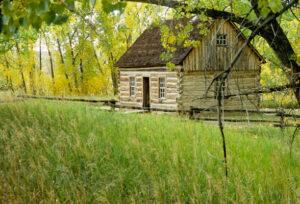
Theodore Roosvelt cabin Theodore Roosevelt NP/George Wuerthner
Theodore Roosevelt first came to ranch among the beautiful badlands along the Little Missouri River in North Dakota in 1884 after his mother died from typhoid fever and within hours his wife, Alice, also died from kidney disease.
Roosevelt was distraught; some say, he went west seeking solace over the loss of his family.
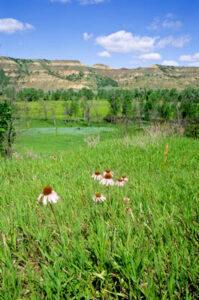
Prairie flowers in Theordore Roosevelt National Park/George Wuerthner
He established two ranches—the Maltese Cross Ranch near Medora and the Elkhorn some 35 miles north of Medora. After the devastating winter of 1886-87 that killed tens of thousands of cattle on the northern plains, Roosevelt decided to get out of the ranching business and focus on politics. He sold his last interests in the Elkhorn Ranch in 1898.
Theodore Roosevelt National Park was first proposed in 1919 shortly after TR died to honor the former President. However, it went nowhere until Franklin Roosevelt proposed in 1942 to add the area to the national park system.
In 1945 North Dakota Congressman William Lemke introduced a bill for a Little Missouri Badlands. But, unfortunately, it failed to get President Truman’s signature. So Lemke tried again in 1947 and got a Theodore Roosevelt Memorial Park managed mainly as a historical site.
Feral horses were present when the memorial Park was established in 1947.
In 1978, the area was upgraded to full national park status, and the NPS began to manage the site more for its natural values. The presence of exotic feral horses has never met the overriding principle of managing native species.
DO FERAL HORSES BELONG IN A NATIONAL PARK?
National Park Service Historian Robert Utley suggested that the horses have historical value and may be descendants of horses once bred by Sitting Bull and other native people.
Of course, all horses are descendants of domestic livestock, whether ridden by Roosevelt or Sitting Bull.
Feral horses are found on other national park units, such as Assateague Island National Seashore. And domestic cattle and horses are currently the subject of a controversial plan to maintain private farms within Point Reyes National Seashore. In addition, there are about 300,000 feral horses on the Bureau of Land Management and national forest lands and state, private and tribal lands across the West.
Many scientists believe feral horses pose a threat to native ecosystem, plants, and wildlife. However, feral horse advocates believe that domestic livestock pose a greater threat to the West’s ecosystems. However, the National Park Service has a different mandate than these other federal land management agencies. As noted by the Theodore Roosevelt National Park Superintendent, the Park Service’s mission is to preserve native species and ecosystems.
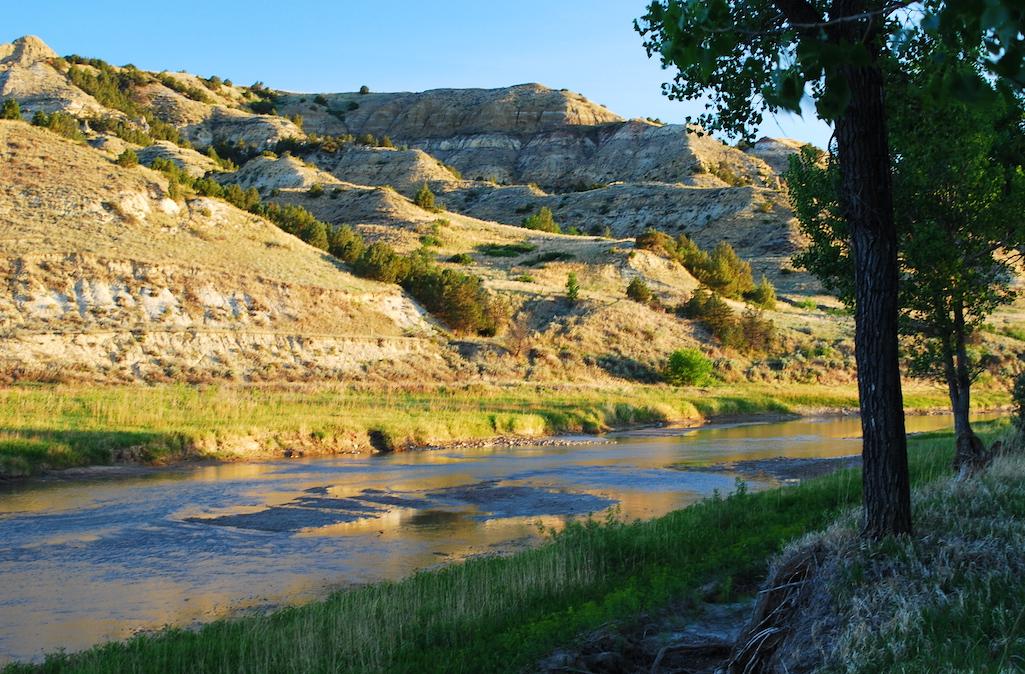
The NPS mission is to preserve the natural environment. Little Missouri River, Theodore Roosevelt National Park/Kurt Repanshek file
FERAL HORSES RELICTS OF SPANISH COLONIZATION
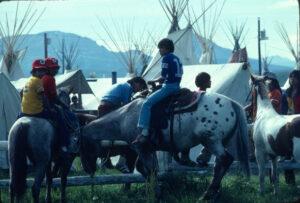
The cultural appropriation of the horse by Native Americans provided greater mobility, leading to more warfare, and the adoption of the bison hunting culture of the Great Plains/George Wuerthner
Horses are not native to North America and were introduced by the Spanish in 1519. Cultural appropriation by the tribes began in the 1600s. Horses reached tribes in the northern plains by 1750-1780, setting the era of mobile bison hunting tradition in motion. The adoption of the horse by Native Americans had both positive and negative influences for them. It also had severe consequences for bison herds, and tribal hunting for the hide trade may have contributed to the demise of the once vast bison herds.
This debate gets to the heart of the matter. Do we need to “preserve” domestic animals in our national parks?
Given that there are hundreds of thousands of feral horses, not to mention about 95 million domestic cattle in the United States, there is no need to keep either cattle or horses in any national park unit.
I commend Superintendent Richman and the Theodore Roosevelt National Park staff for having the courage to recommend removal of domestic animals from the park. However, with the pressure exerted on the Theodore Roosevelt National Park from North Dakota politicians, wild horse advocates, and the United Tribes of North Dakota who suggest feral horses are “sacred” animals, I suspect the National Park Service will bow to the political influence.
The Theodore Roosevelt National Park livestock management plan will be open for public comment later this spring and summer when park staff comes out with a finalized proposal.



Comments
OF COURSE THEY WOULD CALL THE HORSES LIVESTOCK ......THST GIVES THEN CONTROL OF HAVING KILL BUYERS TAKE THEM .....TAXES PAY FIR THIS PARK, "" NO ANIMAL THERE IS VETTED "" ...... NO GIVEN HAY, OR GRAIN. NO DENTIST NO SHOER ....SO HOW MUCH RIGHT DO THEY HAVE IVER ANYONE ELSE ..???
IF THESE HORSES, AND CATTLE REMOVED THEY WILL GO TO SLAUGHTER ....
WHAT DO YOU GET OUT OF IT THAT JUSTIFIES KILLING THEM ALL.
You're totally right. The BLM out west does round up and pay people a thousand dollars to adopt a mustan. Over half of which are then resold and put in kill pens.
There are so many rescues now that deal with mustangs and donkeys that have been sent to the kill pens.
Great Story. We should not let nostalgia get in the way of consse
The article is spot on. The horses and cattle have no business there and are degrading the habitat for native wildlife.
The horses on Cumburland Island are sick and diseased.
It is cruel and unusual punishment to keep them roaming free.
The manure and flys are sickening. People can see houses every day. Horse are not unique animals or endangered. Cumburland Island would be more beautiful without these poor sickly animals.
There are currently 185 horses in TRNP. Inflating the numbers to try to make your case, when they are so closely monitored by volunteers, doesn't work. Get your facts straight, George. If the horses are considered "livestock," then so are the bison, especially since they have domestic cattle blood in them and are not generally pure. Guess we should get rid of them, too, huh? They're much less individual than the horses after all. If you don't like the horses, you're free not to visit the park. Those of us who do, for now, will.
How can you call these horses livestock? You do not feed them or care for them in anyway! Why is it that the name of the game in this country is too be as unkind and mean as you can when you know so many people love and enjoy these wild horses. I have no interest in looking at land devote of horses. Sending horses to kill pens is one of cruelest things you can do. You are showing yourselves to be heartless and I plan to have no part of Roosevelt Park if you get rid of the wild horses!
Well considering bison are:
1. Native to North America
2. Native to North Dakota
3. The national mammal
4. Not an invasive species like the horses are
5. Not livestock (look up CFR for definition of livestock)
6. Managed by the park just like the FERAL horses.....
your "argument" is flawed.